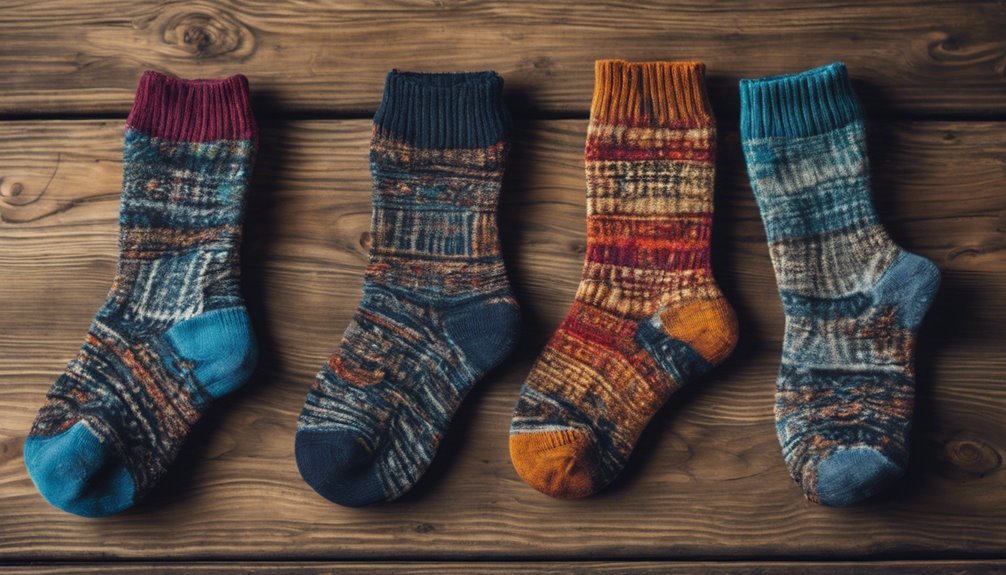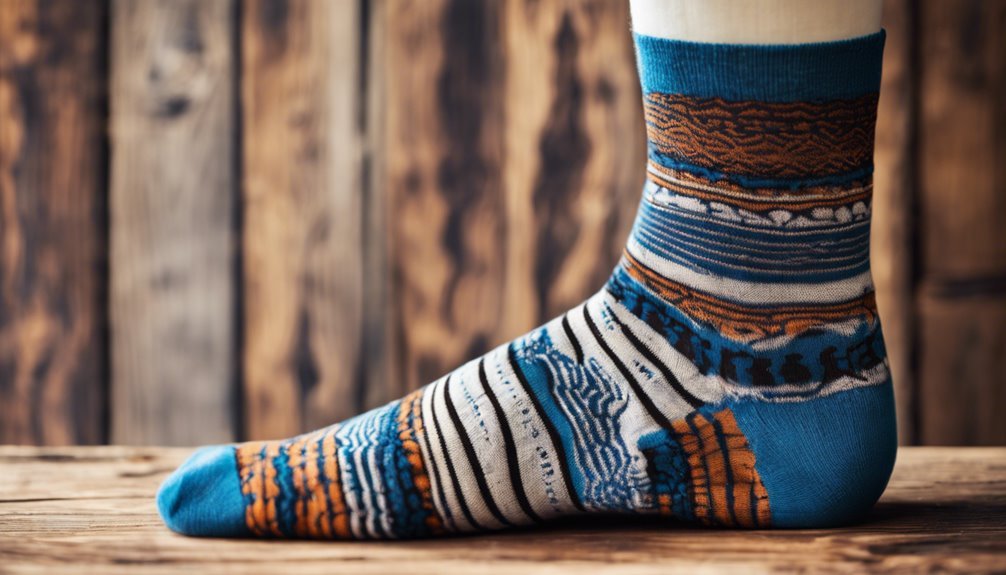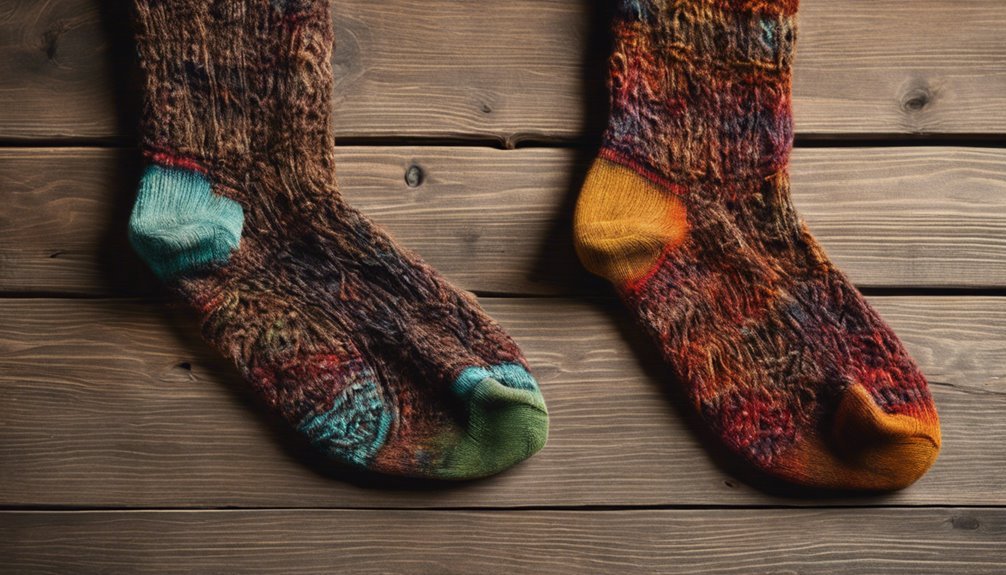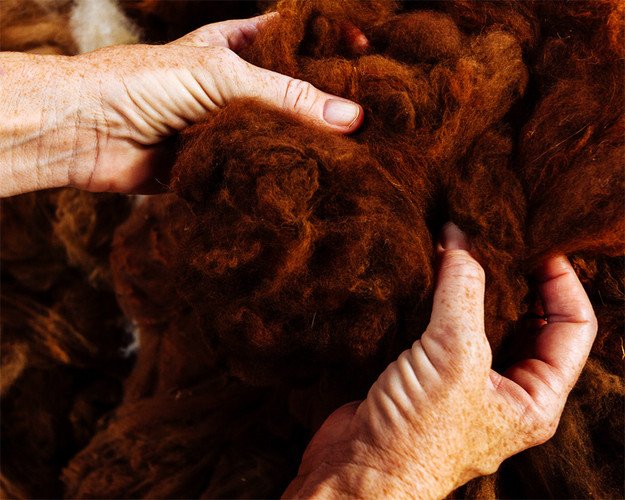Handmade Socks vs. Machine-Made Socks: Which Is More Durable?
When comparing durability, handmade socks typically outperform machine-made options. Their superior craftsmanship and attention to detail enhance wear resistance and longevity. Skilled artisans use high-quality, natural materials like merino wool, which contribute to their durability. In contrast, machine-made socks, while cost-effective, often rely on lower-grade materials and uniform production standards, potentially sacrificing longevity. If you want to understand the finer points of sock choices, including factors that affect your decision, there's more to explore.
Understanding Handmade Socks: Craftsmanship and Material Quality

When you consider the world of socks, the distinction between handmade and machine-made options often hinges on craftsmanship and material quality. Handmade socks are typically the result of meticulous craftsmanship details, where skilled artisans select premium material sources that enhance durability and comfort. Each stitch is often executed with precision, reflecting the maker's dedication to quality. You'll find that handmade socks frequently use natural fibers, such as merino wool or organic cotton, which not only provide breathability but also contribute to longevity. This attention to detail in both construction and material selection sets handmade socks apart, allowing for a unique fit and feel that machine-made counterparts often lack. Ultimately, the choice of handmade socks signifies a commitment to superior craftsmanship and sustainable practices.
The Appeal of Machine-Made Socks: Efficiency and Cost-Effectiveness
While handmade socks boast unique craftsmanship, machine-made socks provide undeniable advantages in efficiency and cost-effectiveness. With advancements in technology, machine efficiency allows for rapid production without compromising basic quality. This means you can enjoy a wide variety of styles and materials at a fraction of the cost. Additionally, the streamlined manufacturing process translates to significant cost savings for both producers and consumers. You'll find that machine-made socks often come with lower price points, making them accessible to a broader audience. For those looking to balance budget and variety, machine-made options deliver practical solutions without sacrificing essential functionality. Ultimately, the appeal lies in the ability to acquire quality socks quickly and economically, meeting contemporary demands for convenience.
Comparing Durability: Handmade vs. Machine-Made
Although both handmade and machine-made socks serve the same primary function, their durability can vary considerably based on their construction methods. Handmade socks often showcase superior craftsmanship, with attention to detail that enhances durability factors such as stitch tightness and material choice. This can lead to better wear resistance, especially in high-friction areas. Conversely, machine-made socks benefit from consistent production techniques, which can guarantee uniformity in material quality but may sacrifice some durability due to mass production standards. Additionally, the fibers used in machine-made options might not be as robust, affecting their long-term performance. Ultimately, your choice between handmade and machine-made socks should consider these durability aspects to match your lifestyle and needs effectively.
Longevity: Which Socks Stand the Test of Time?

When considering longevity, the materials used in sock construction play an essential role in how long they last. Additionally, stitching techniques and patterns can greatly impact their durability, influencing wear and tear over time. Finally, proper care and maintenance can extend the lifespan of both handmade and machine-made socks, making it essential to understand the best practices for each type.
Materials Used in Construction
The durability of socks largely hinges on the materials used in their construction. Different sock fibers, such as merino wool, cotton, and synthetic blends, each offer unique benefits and drawbacks. For instance, merino wool excels in moisture-wicking and temperature regulation but may wear faster than nylon blends under durability evaluation. Cotton, while breathable, can lose its shape and strength over time. Synthetic fibers, like polyester and nylon, are engineered for resilience, often outperforming natural fibers in longevity. When examining durability, consider how these materials interact with your lifestyle. Your choice should align with your needs for comfort and endurance, ensuring your socks can withstand daily wear while retaining their performance characteristics.
Stitching Techniques and Patterns
While many may overlook stitching techniques and patterns, they play an essential role in determining the longevity of socks. Different stitching styles—like ribbing, purling, or flat-knit—can greatly affect durability. For instance, ribbed patterns create elasticity, which helps maintain sock shape over time. In contrast, flat-knit techniques, while smooth, may lack the resilience needed for frequent wear.
Moreover, pattern variety, such as reinforced heels and toes, provides targeted strength in high-friction areas. These design elements can prevent premature wear and enhance overall lifespan. When choosing socks, consider how these stitching techniques and patterns align with your lifestyle. Ultimately, the right combination can guarantee that your socks not only look good but also stand the test of time.
Care and Maintenance Tips
Although proper care and maintenance can greatly extend the lifespan of socks, many people often underestimate its importance. For ideal sock washing, use cold water and a gentle cycle to protect fibers from wear. When it comes to storage tips, keep your socks in a cool, dry place, avoiding direct sunlight to prevent fading and deterioration. If you notice any small holes, employing simple repair techniques like darning can prolong their life considerably. Additionally, practice effective odor management by allowing socks to air out after use and considering baking soda in storage to absorb unwanted smells. By following these guidelines, you can guarantee that both handmade and machine-made socks stand the test of time, giving you the freedom to enjoy them longer.
Environmental Impact: Sustainability of Handmade and Machine-Made Socks
When considering the environmental impact of handmade versus machine-made socks, it is crucial to examine the entire production process. Handmade socks often utilize sustainable materials, such as organic cotton or wool, minimizing the carbon footprint associated with synthetic fibers. Artisans typically employ eco-friendly practices, such as dyeing with natural pigments and reducing waste through careful design. In contrast, machine-made socks, while efficient in production, frequently rely on mass-produced materials that may not prioritize sustainability. The energy consumption in large-scale manufacturing can be significant, contributing to environmental degradation. Ultimately, choosing handmade socks can align with a commitment to sustainability, as they often embody a more conscientious approach to resource use and ecological responsibility, giving you the freedom to support environmentally friendly practices.
Making the Right Choice: Factors to Consider When Buying Socks
When choosing socks, you should evaluate material quality, as it directly affects comfort and durability. Consider the craftsmanship and techniques used in production, since these factors influence the overall performance and fit. Finally, weigh the price against the expected longevity to guarantee you're making a cost-effective decision.
Material Quality Comparison
While choosing between handmade and machine-made socks, the quality of materials used plays a crucial role in your decision. Handmade socks often feature carefully sourced materials, prioritizing natural fibers like wool and cotton, which enhance breathability and comfort. In contrast, machine-made socks may utilize synthetic blends that can compromise durability and moisture-wicking capabilities. The production methods also influence material quality; handmade socks allow for greater control over the sourcing process, ensuring higher standards. Conversely, mass production can lead to cost-cutting, affecting the overall integrity of materials. When evaluating your options, consider how these factors align with your preferences for comfort and longevity, ultimately guiding you toward a choice that meets your desired level of freedom and quality in footwear.
Craftsmanship and Techniques
Understanding the craftsmanship and techniques behind sock production can considerably impact your purchasing decision. When evaluating socks, pay attention to knitting techniques and craftsmanship standards, as these factors directly influence durability and comfort.
| Feature | Handmade Socks | Machine-Made Socks |
|---|---|---|
| Knitting Techniques | Intricate patterns, custom fit | Standardized patterns, uniform fit |
| Craftsmanship Standards | High attention to detail | Variable quality control |
| Durability | Generally longer-lasting | May wear out faster |
Price vs. Longevity
Choosing between handmade and machine-made socks often comes down to a balance between price and longevity. While handmade socks typically carry a higher price perception, they may offer superior longevity value. Here are some factors to evaluate:
- Material Quality: Handmade socks usually use higher-quality fibers, enhancing durability.
- Craftsmanship: The meticulous techniques in handmade options can lead to fewer defects over time.
- Wear Cycle: Machine-made socks might wear out faster, necessitating more frequent replacements.
- Cost Efficiency: Initially, machine-made socks seem cheaper, but their short lifespan can lead to higher overall costs.
Ultimately, weigh these factors carefully to determine which option aligns better with your values and budget.
Frequently Asked Questions
How Do I Care for Handmade Socks to Prolong Their Life?
To prolong your handmade socks' life, focus on gentle sock washing techniques. Use cold water and mild detergents, avoiding harsh chemicals. Proper fiber preservation guarantees elasticity and color retention, maintaining their quality for longer periods.
Are Machine-Made Socks Suitable for Sensitive Skin?
Machine-made socks can be suitable for sensitive skin, depending on their material. You should check for hypoallergenic fabrics and avoid synthetic materials that may trigger material sensitivity, ensuring comfort and reducing irritation during wear.
Can I Customize the Fit of Handmade Socks?
Absolutely, you can customize the fit of handmade socks! Imagine socks tailored to your feet's exact contours, featuring custom sizing and personalized designs that embrace your individuality, offering unparalleled comfort and style for every occasion.
What Materials Are Commonly Used in Machine-Made Socks?
Machine-made socks typically utilize cotton blends for comfort and breathability, while synthetic fibers enhance durability and moisture-wicking properties. This combination allows you to enjoy both performance and comfort in various conditions.
How Do Handmade Socks Compare in Weight to Machine-Made Options?
When it comes to handmade sock weight versus machine-made weight, you'll find that handmade options often possess a delightful heft, offering warmth and comfort, while machine-made versions tend to be lighter, prioritizing mass production efficiency.







